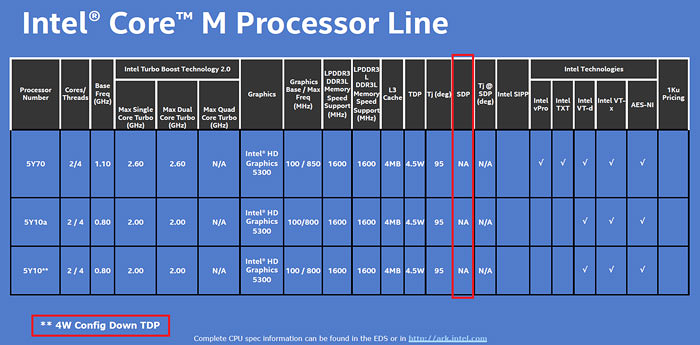Intel Corp. has revealed detailed specifications of the first Core M microprocessors based on the “Broadwell” architecture. While the new processors will clearly not be performance champions, they will consume significantly lower amount of energy compared to existing chips and will enable extremely thin tablets, 2-in-1s and laptops.
“We've been on a multi-year mission to address end-user requirements and transform mobile computing,” said Kirk Skaugen, senior vice president and general manager of personal computing at Intel Corporation. “The introduction of Core M marks a significant milestone in that journey. Core M is the first of a new product family designed to deliver the promise of one of the world's thinnest laptops and highest performance tablets in a single 2 in 1 device.”
The first “Broadwell” processors are Core M 5Y70, 5Y10 and 5Y10A. The chips feature two x86 cores with the Hyper-Threading technology, the Intel HD Graphics 5300 graphics core with 24 execution units and various enhancements, 3MB of L3 cache, dual-channel DDR3 memory controller as well as a core-logic placed on the same piece of substrate as the processor. What is important is that the chips feature 4.5W thermal design power, which is significantly lower compared to TDP's of today’s Core i-series chips. While the new chips are based on high-performance “Broadwell” micro-architecture, their power consumption is even lower than that of Atom processors that use low-power micro-architecture. The new processors are also 50 per cent smaller than their predecessors.

Image by ComputerBase.de web-site.
At IFA trade-show in Berlin, Germany, manufacturers including Acer, Asustek Computer, Dell, HP, and Lenovo unveiled new, coming-soon Intel Core M processor-based devices across a range of sizes, styles and price points. The first Core M-powered product from Lenovo – the new ThinkPad Helix – will become available already in October.
Discuss on our Facebook page, HERE.
KitGuru Says: While the Broadwell chips will not dliver leading-edge performance initially, they will enable PC makers to build devices not possible before. For example, thin tablets with long battery life, Windows operating and high-performance x86 architecture are now reality.
 KitGuru KitGuru.net – Tech News | Hardware News | Hardware Reviews | IOS | Mobile | Gaming | Graphics Cards
KitGuru KitGuru.net – Tech News | Hardware News | Hardware Reviews | IOS | Mobile | Gaming | Graphics Cards



self-publishing without editing is a major no-no. just sayin’.